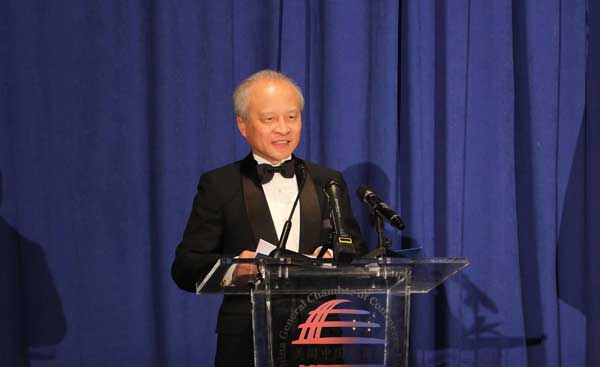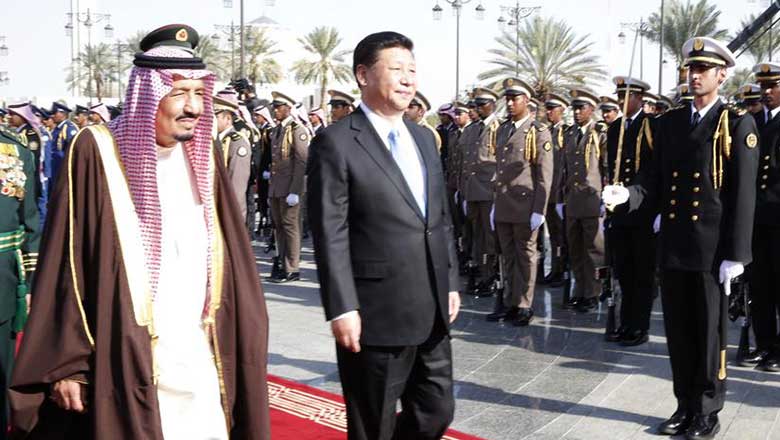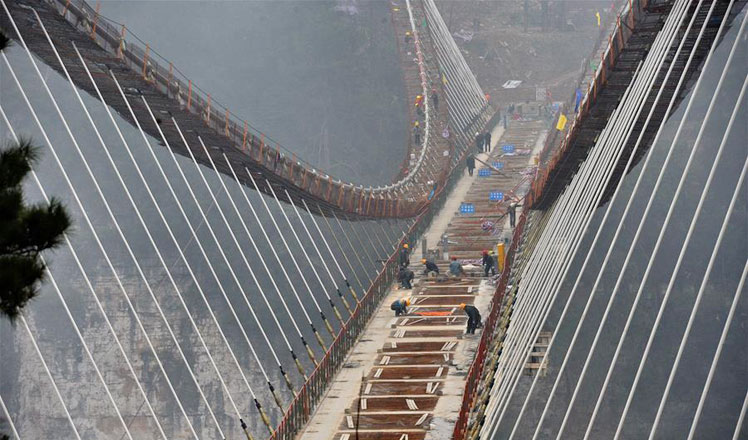Building a new world model
Updated: 2016-01-21 00:11
(China Daily USA)
|
||||||||
EDITOR'S NOTE: Following is the full text of a speech given by Chinese Ambassador to the US Cui Tiankai at the 2016 New Year Celebration Gala Dinner of the China General Chamber of Commerce—USA in New York City on Tuesday.
 |
|
Chinese Ambassador to the US Cui Tiankai delivers keynote speech at the dinner gala of the China GeneralChamber of Commerce—USA in New York on Tuesday. XIAO HONG / CHINA DAILY |
Mr. Chairman,
Ladies and gentlemen,
Thank you for your kind remarks. It is great to join you in this New Year celebration.
We are less than three weeks into 2016. Yet the new year is already quite eventful. It is a year of crucial importance for all of us.
For China, 2016 marks the start of the 13th Five-year Plan. It is the last mile we have to travel before realizing the first centenary goal to double the 2010 GDP and per capita income and build a society of moderate prosperity in all respects by 2020. For the United States, the American people will elect a new President and a new Congress, a critical choice up to the American people to make. For the China-US relationship, the good momentum brought about by the successful state visit of President Xi Jinping last September must be strengthened in the new year. The two countries must work together to ensure a smooth transition of their relationship into the next year and pave the way for its irreversible growth in the years and even decades to come.
These are our New Year resolutions — for China, for the United States, and for China-US relations.
Let's have a closer look at what China has to do. Today China's per capita GDP is around $7,400. It will reach $12,000 by 2020 if we maintain an annual growth rate of about 7% in the next five years. In the meantime, China must lift more than 70 million people out of poverty, meaning over 10 million every year, and more than one million every month. Then we can say for sure that China has overcome the so-called “Middle Income Trap”. This will indeed be a lofty goal for a country with over 1.3 billion people. It will also be an important contribution to development, prosperity and peace of mankind.
To do this, China is further deepening its reform in all respects and implementing a development approach that is characterized by five key concepts: innovation, coordination, green growth, openness and sharing.
Innovation means that we will transform the pattern of economic growth for it to be driven by innovation. Coordination means that we will try to promote political, economic, cultural, social and ecological development at the same time, and bring about balanced development between rural and urban areas and between different regions of the country. Green growth means that we will highlight green and low-carbon development and put even greater emphasis on environmental quality. Openness means that we will keep our door open to the outside world and continue to pursue an opening-up strategy that brings mutual benefits. Sharing means that we will not only make the pie of development bigger, but also ensure its better distribution so that the benefits are shared by all.
When this is achieved, we will move on towards the second centenary goal, which is to build China into a modern socialist country that is prosperous, strong, democratic, culturally advanced, and harmonious by the centenary of the PRC.
These two centenary goals are by no means easy tasks. As Dr. Henry Kissinger has observed, what China is doing is like the “third revolution” in the contemporary history of the country. Indeed, this is a revolution that will enable an ancient nation to modernize itself. This is a strategy that will meet the growing aspirations of the Chinese people and serve their best interests. When these goals are realized, the Chinese nation will see its dream come true.
Our dream is defined by how we see the world in the 21st century.
We believe that the world today is undergoing profound changes. Peace and development remain its defining feature. At the same time, mankind is faced with unprecedented challenges. The world is increasingly becoming a community of common destiny. No country can insulate itself from the threat of terrorism, the risk of financial contagion, the threat of infectious diseases, or the impact of climate change. No country can deal with these challenges single-handed. They call for greater cooperation among nations. They make us partners with each other. Zero-sum game and “winner takes all” are obsolete mindsets, and will only lead to a situation of no winner at all.
With this world outlook, China has chosen the path of peaceful development. We are convinced that such a path will best serve China's development needs while bringing benefits to the international community as a whole. We reject the assertion that confrontation between rising and established powers is inevitable. We are confident that the so-called “Thucydides Trap” can and will be avoided if our view of the world and our commitment to community building are shared by others.
It is with this in mind that we see the need to build a new model of major-country relationship with the United States. This new model is both a long-term goal and an ongoing process. It is both a set of guiding principles and an operational framework. It calls on the two countries to take a constructive and creative approach to deepen mutual trust, expand cooperation, and properly handle differences. It provides us with a clear sense of direction in our daily work. And what we do everyday helps it take shape. It will adapt to changing situations and will probably take up new dimensions. Yet its key features are always clear — no conflict or confrontation, mutual respect, and win-win cooperation.
China has no intention nor the capabilities to challenge the leading role of the United States in the world. We are still a large and diverse developing country with more than 1.3 billion people. Our priorities are domestic. Our biggest ambition is better life for our people.
China recognizes US interests in the Asia-Pacific. We welcome a constructive and positive role by the United States in the region. As President Xi jinping pointed out, the Pacific is vast enough for both China and the United States to develop. We do not and will not embrace any new version of the Monroe Doctrine. We are opposed to any attempt to draw a dividing line in the region between exclusive and confrontational blocs, whether military or economic ones. The Asia-Pacific should not become an arena of major power rivalry. No country, big or small, can gain anything from it. All of us should work together to make our region a bright spot of peace and stability on the world scene, and a stronger engine of growth for the global economy.
China and the United States share the responsibility with the rest of the world to maintain and improve the current international order. Together we should aim for a better global governance. Of course, setting international rules is not a matter of “either/or”, that is, either by the United States or by China. Nor should it be a matter between us. It is a task for all members of the international community.
China's development has benefited from the current international order. We have also participated in and contributed to it as it evolves. As China grows stronger, we are ready to take up more international responsibilities and make greater contributions. The Belt and Road Initiative, the establishment of the Silk Road Fund, and the AIIB, which started its operation last week, are all designed for this purpose. We hope that the United States will also be our partner in these projects.
Naturally, China and the United States do not see eye-to-eye with each other on everything. Probably there will never be a day when the two countries have no differences at all.
But we should not get lost when we are confronted with tough issues. We should not give up when seemingly insurmountable barriers arise. We should not allow ourselves to be confused and misled by suspicion or fear. We should always keep in sight our growing mutual needs and common interests. We should always handle the differences creatively, constructively and confidently. In fact, this is what the new model of relationship is all about.
Ladies and Gentlemen,
In building up this new model of relationship, we will continue to count on the support of the business communities of the two countries. China is now the United States largest trading partner, and provides a market worth of $450 billion for American goods and services. At the same time, Chinese investment in the United States is growing rapidly. It has outpaced annual US investment in China. These investment flows deliver benefits to both Chinese and Americans, including more jobs and more competitive consumer markets. They also help cement China-US relations.
In this connection, I would like to extend my sincere appreciation to the Chinese and US businesses for your longstanding support and contribution to China-US relations over the years. I hope that Chinese companies in the United States will continue to act as Chinese ambassadors of good will, and continue to learn from your US counterparts, assume more corporate social responsibilities, and contribute more to the local communities where you are operating.
As the Chinese Lunar Year of the Monkey is just around the corner, I would like to wish you all a happy and prosperous New Year. In Chinese culture, Monkey is a symbol of smartness. I hope that in 2016, both countries and peoples will make smart and right choices to realize our New Year resolutions.
Thank you.
- Railway police nab 40,315 fugitives in 2015
- China issues blue alert for snow storms
- Blast in firework factory leaves four missing, four injured
- Struggles of a Shanxi coal mine owner in bleak industry winter
- China launches system to check authenticity of living buddhas
- China sees rising online fraud in 2015: report
- Former US VP candidate Palin endorses Trump with a 'hallelujah'
- Gunmen kill at least 19 after storming Pakistan university
- Hollande makes last-chance push to curb French unemployment
- Taxi drivers block central Budapest all day in protest against Uber
- Police respond to reports of shooting at Sydney police station
- Okinawa squares up to Tokyo over US base row

 Xi boosts ties with Saudis
Xi boosts ties with Saudis
 Cold wave sweeps across China
Cold wave sweeps across China
 Internet tycoons' wacky costumes are annual galas' highlight
Internet tycoons' wacky costumes are annual galas' highlight
 Culture Insider: 6 things you may not know about Major Cold
Culture Insider: 6 things you may not know about Major Cold
 Chinese shoppers' 10 favorite destinations in 2015
Chinese shoppers' 10 favorite destinations in 2015
 Glass bridge across Zhangjiajie Grand Canyon under construction
Glass bridge across Zhangjiajie Grand Canyon under construction
 The life of a wood carving artist
The life of a wood carving artist
 Glenn Frey, founding member of the Eagles, dead at 67
Glenn Frey, founding member of the Eagles, dead at 67
Most Viewed
Editor's Picks

|

|

|

|

|

|
Today's Top News
National Art Museum showing 400 puppets in new exhibition
Finest Chinese porcelains expected to fetch over $28 million
Monkey portraits by Chinese ink painting masters
Beijing's movie fans in for new experience
Obama to deliver final State of the Union speech
Shooting rampage at US social services agency leaves 14 dead
Chinese bargain hunters are changing the retail game
Chinese president arrives in Turkey for G20 summit
US Weekly

|

|







